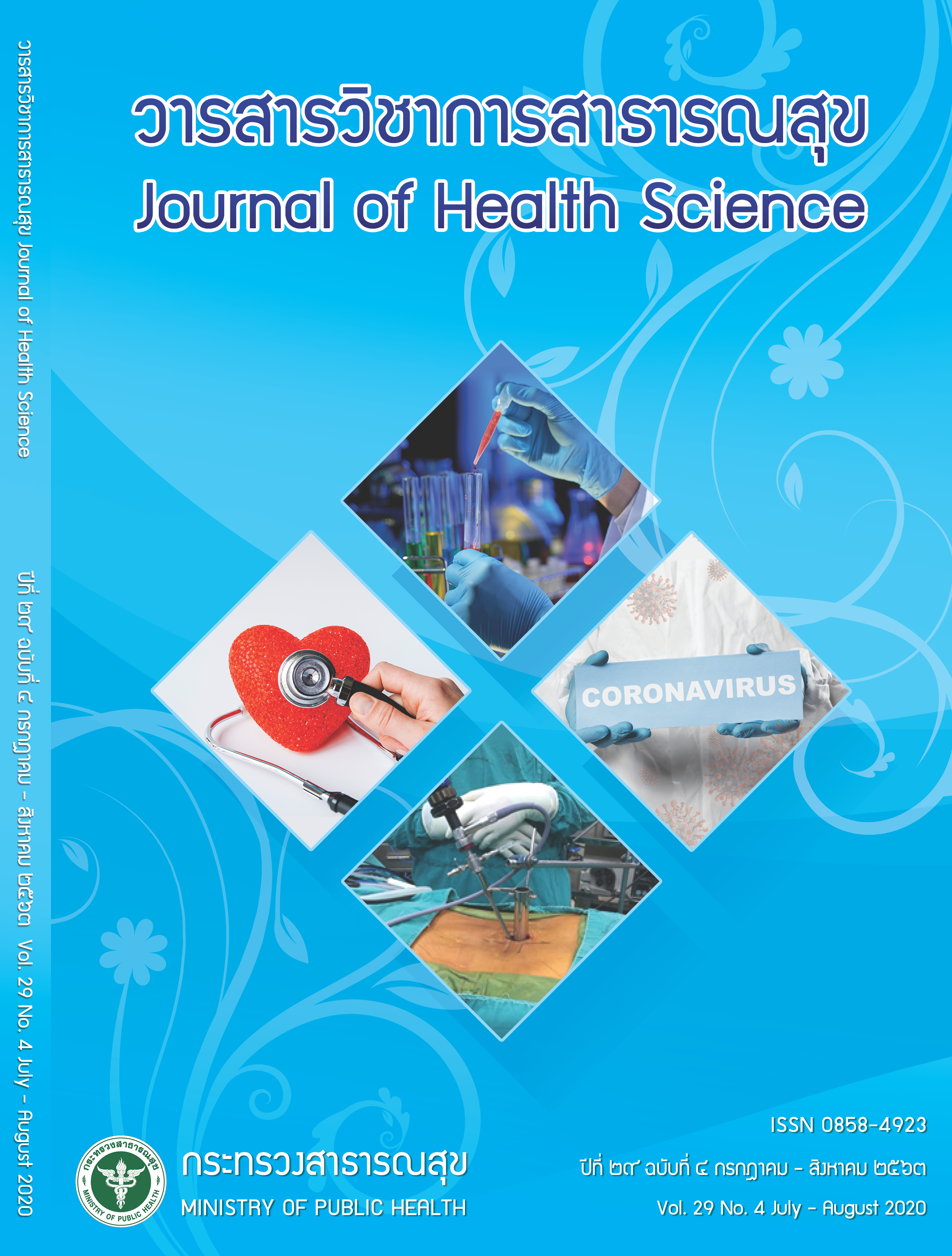การศึกษาประสิทธิผลของสารเคมี Deltamethrin และ Cypermethrin ต่อยุงลายบ้านพาหะนำโรคไข้เลือดออกสายพันธุ์ต้านทานและสายพันธุ์ที่ไวต่อสารเคมี
คำสำคัญ:
ยุงลายบ้าน, โรคไข้เลือดออก, สาร deltamethrin, สาร cypermethrin, ความต้านทานต่อสารเคมีกำจัดแมลงบทคัดย่อ
การศึกษาฤทธิ์ทำให้แมลงหงายท้องและฤทธิ์ในการฆ่าแมลงของสาร deltamethrin และ cypermethrin ที่อัตราการใช้ 0.025, 0.05, 0.1, 0.15 และ 0.2 g a.i./m2ต่อยุงลายบ้านจากจังหวัดระยองและจันทบุรีเปรียบเทียบกับยุงลายบ้านจากห้องปฏิบัติการที่มีความไวต่อสารเคมีด้วยวิธีทดสอบมาตรฐานจากองค์การอนามัยโลก (WHO susceptibility test) เพื่อหาอัตราการใช้ที่เหมาะสมของสาร deltamethrin และ cypermethrin ในการควบคุมยุงลายบ้านที่มีความต้านทานต่อสารเคมีทั้งสองชนิด ผลทดสอบความไวต่อสารเคมีพบว่ายุงลายบ้านทั้งสองพื้นที่มีความต้านทานใน ระดับปานกลางต่อ deltamethrin และมีความต้านทานในระดับสูงต่อ cypermethrin ผลทดสอบฤทธิ์ทำให้แมลงหงายท้องและฤทธิ์ในการฆ่าแมลงของสารเคมีทั้งสองชนิดพบว่า deltamethrin ที่อัตราการใช้ 0.15 และ 0.2 g a.i./m2สามารถทำให้ยุงลายจากจังหวัดระยองและจันทบุรีตายร้อยละ 100.0 สำหรับ cypermethrin ที่อัตราการ 0.15 และ0.2 g a.i./m2สามารถทำให้ยุงลายจากระยองตายร้อยละ 91.3-97.0 แต่ยุงลายจากจันทบุรีตายร้อยละ 89.8-92.4 นอกจากนี้สาร deltamethrin ยังมีฤทธิ์ทำให้ยุงลายทดสอบหงายท้องได้เร็วกว่า cypermethrin ดังนั้น deltamethrin ที่อัตราการใช้ 0.15 และ 0.2 g a.i./m2 ยังคงมีประสิทธิภาพดีในการทำให้ยุงลายบ้านหงายท้องและตาย ซึ่งสามารถนำไปศึกษาเพิ่มเติมในการฉีดพ่นแบบตกค้างบนพื้นผิววัสดุตามแหล่งที่ยุงลายชอบเกาะพักโดยเฉพาะในพื้นที่ที่มีการระบาดของโรคไข้เลือดออกและยุงลายมีการสร้างความต้านทานต่อสารเคมีกลุ่มไพรีทรอยด์ ซึ่งป็นอีกวิธีหนึ่งที่จะช่วยเสริมให้การควบคุมยุงลายมีประสิทธิภาพมากยิ่งขึ้นนอกเหนือจากการฉีดพ่นแบบฟุ้ งกระจายกำจัดตัวเต็มวัยและการใช้สารเคมีกำจัดลูกน้ำยุงลาย
Downloads
เอกสารอ้างอิง
Thongrungkiat S, Maneekan P, Wasinpiyamongkol L, Prummongkol S. Prospective field study of transo-varial dengue-virus transmission by two different forms of Aedes aegypti in an urban area of Bangkok, Thailand. J Vector Ecol 2011;36(1):147-52.
สำนักโรคติดต่อนำโดยแมลง. หนังสือรายงานประจำปี 2559 สำนักโรคติดต่อนำโดยแมลง. กรุงเทพมหานคร: อักษรกราฟฟิ คแอนด์ดีไซน์; 2560.
Rozendaal JA, World Health Organization. Vector con-trol: methods for use by individuals and communities. Geneva: World Health Organization; 1997.
Hladish TJ, Pearson CAB, Patricia Rojas D, Go-mez-Dantes H, Halloran ME, Vazquez-Prokopec GM, et al. Forecasting the effectiveness of indoor residual spray-ing for reducing dengue burden. PLoS Negl Trop Dis 2018;12(6):e0006570.
Lei W, Wang DD, Dou TY, Hou J, Feng L, Yin H, et al. Assessment of the inhibitory effects of pyrethroids against human carboxylesterases. Toxicol Appl Pharma-col 2017;321:48-56.
วิชัย สติมัย. การศึกษาการใช้สารเคมีและความต้านทานของยุงพาหะต่อสารเคมีในภาคตะวันออกของประเทศไทย. วารสารโรคติดต่อนำโดยแมลง 2553;7(2):18-30.
สำนักโรคติดต่อนำโดยแมลง. หนังสือรายงานประจำปี 2560 สำนักโรคติดต่อนำโดยแมลง. กรุงเทพมหานคร: อักษรกราฟฟิ คแอนด์ดีไซน์; 2561.
สำนักโรคติดต่อนำโดยแมลง. สรุปรายงานสถานการณ์โรคไข้เลือดออก พ.ศ. 2558-2559 [อินเทอร์เน็ต]. [สืบค้นเมื่อ 27 ก.ค. 2561]. แหล่งข้อมูล: http://www.thaivbd.org/dengue_history.php
World Health Organization. Test procedures for insecti-cide resistance monitoring in malaria vectors, bio-effi-cacy and persistence of insecticides on treated surfaces. Geneva: World Health Organization; 1998.
World Health Organization. Test procedures for insecti-cide resistance monitoring in malaria vevtor mosquitoes. Second edition. Geneva: World Health Organization; 2016.
สิทธิพร นามมา, วาสนา สอนเพ็ง, ศศิธร แพนสมบัติ. การทดสอบความไวของยุงลายต่อสารกำจัดแมลงกลุ่มไพรีทรอยด์สังเคราะห์. วารสารสำนักงานป้ องกันควบคุมโรคที่ 7 จังหวัดขอนแก่น 2557;21(1):87-96.
Abbott WS. A method for computing the effectiveness of an insecticide. 1925. J Am Mosq Control Assoc 1987;3(2):302-3.
Jirakanjanakit N, Bongnoparut P, Saengtharatip T, Yok-san S. Insecticide susceptible/resistance status in Aedes (Stegomyia) albopictus (Diptera: Culicidae) in Thailand during 2003-2005. J Econ Entomol 2007;100(2):545-50.
Paeporn P, Supaphathom K, Sisawat R, Komalamisra N, Deesin V, Ya-umphan P, et al. Biochem detection of pyrethroid resistance mechanisms in Aedes aegypti in Ratchaburi province Thailand. Trop Biomed 2004; 21(2):145-51.
Thanispong K, Sathantriphop S, Chareonviriyaphap T. Insecticide resistance of Aedes aegypti and Culex quinquefasciatus in Thailand. J Pestic Sci 2008;33(4):351-6.
คณัจฉรีย์ ธานิสพงศ์, ขนิษฐา ปานแก้ว, ประชา สุขโชติ. ความไว/ความต้านทานสารเคมีกำจัดแมลงของยุงลายบ้านต่อสารเคมีกำจัดแมลงที่ใช้ในงานสาธารณสุข. วารสารโรค-ติดต่อนำโดยแมลง 2554;8(2):28-43.
Thongwat D, Bunchu N. Susceptibility to temephos, permethrin and deltamethrin of Aedes aegypti (Diptera: Culicidae) from Muang district, Phitsanulok Province, Thailand. Asian Pac J Trop Med 2015;8(1):14-8.
ทัศนีย์ เอกวานิช, ยุวดี ตรงต่อกิจ, สุวิทย์ เพ็งพิศ. ความไวของยุงลายบ้านและยุงรำคาญต่อสารเดลต้ามิทรินในเขตเทศบาลนครภูเก็ต. วารสารวิชาการสาธารณสุข 2557; 23(6):1108-14.
Floore TG, Rathburn CB Jr, Boike AH Jr, Coughlin JS, Greer MJ. Comparison of the synthetic pyrethroids es-biothrin and bioresmethrin with scourge and cythion against adult mosquitoes in a laboratory wind tunnel. J Am Mosq Control Assoc 1992;8(1):58-61.
Davies TG, Field LM, Usherwood PN, Williamson MS. DDT, pyrethrins, pyrethroids and insect sodium channels. International Union of Biochemistry and Molecular Bi-ology Life 2007;59(3):151-62.
CheMendoza A, Guillermo-May G, Herrera-Bojórquez J, Barrera-Pérez M, Dzul-Manzanilla F, Gutierrez-Cas-tro C, et al. Long-lasting insecticide treated house screens and targeted treatment of productive breeding-sites for dengue vector control in Acapulco, Mexico. Trans R Soc Trop Med Hyg 2015;109(2):106-15.
Mushtaq S, Mukhtar MU, Arslan A, Zaki AB, Hammad M, Bhatt A. Probing the residual effects of deltamethrin on different surfaces against malaria and dengue vector in Pakistan by designing laboratory model. J Entomol Zool Stud 2015;3(4):440-3
Insecticide Resistance Action Committee (IRAC). Pre-vention and management of insecticide resistance in vectors of public health importance. 2nd edition [Internet]. 2011 [cited 2018 Jul 27]. Available from: https://irac-online.org/content/uploads/2009/09/VM-Lay-out-v2.6_LR.pdf
ดาวน์โหลด
เผยแพร่แล้ว
วิธีการอ้างอิง
ฉบับ
บท
การอนุญาต

This work is licensed under a Creative Commons Attribution-NonCommercial-NoDerivatives 4.0 International License.







